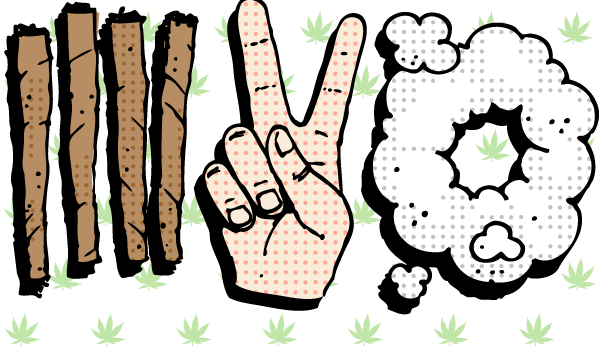The Story Behind 4/20 and Its Founders
These days, even people far removed from cannabis culture know one thing about the plant: the “official” international holiday for cannabis consumption falls on April 20th. However, when it comes to the origins of this date and the name “4/20,” many people are left puzzled. Why April 20th, and why the number 4/20?
Some claim that 4/20 is a police code in America for “caught marijuana smokers,” but that’s an obvious myth. Others, including conspiracy theorists, suggest the number is somehow linked to Hitler’s birthday, which also falls on April 20th, but the real story is much simpler.
The True Origins: The “Waldos” and 4:20 PM
The history of “4/20” dates back to 1971, to a group of five teenage friends attending San Rafael High School in Marin County, California—a place well-known in cannabis circles. These friends loved to smoke after school, usually around 4:20 PM local time. The group called themselves the “Waldos,” and history has preserved the names of the original “fathers of 4/20”: Steve Capper, Dave Reddix, Jeffrey Noel, Larry Schwartz, and Mark Gravich. All of them still live in Northern California, keep in touch, and naturally get together every year on April 20th.
According to Dave Reddix’s brother, who spoke with journalists, the term “4/20” spread beyond their circle thanks to the band The Grateful Dead, with whom Dave Reddix worked as a roadie. As the story goes, Reddix told bassist Phil Lesh about their unique tradition. At the band’s next concert on December 28, 1990, in Oakland, they handed out flyers to fans, mentioning the now-famous number and explaining it as the optimal time and day to smoke cannabis—April 20th at 4:20 PM. Steve Bloom, a former reporter for High Times magazine, still has a copy of the original flyer. In 1991, the band continued distributing flyers at concerts, encouraging fans to honor 4/20. From there, the story of the cannabis holiday spread across the U.S. and eventually became an international phenomenon. The true origin of the date was uncovered in 1998, when journalists tracked down the “Waldos,” the real founders of the 4/20 story.
Interviews with the Founders
Recently, TIME magazine journalists interviewed two of the “Waldos”: Dave Reddix, a former CNN cameraman and now a documentarian, and Steve Capper, who now runs his own staffing agency.
According to the creators of the 4/20 meme, there’s no hidden meaning in the number: it simply marks the optimal time for smoking, which happened to be about an hour and a half after school ended at 3:00 PM. The teens would finish classes, find a spot—usually under the bleachers at the school stadium—and start enjoying cannabis around 4:20 PM. This ritual became a marker for their group within the school’s subculture hierarchy.
“We were on our own wavelength and wanted to avoid the attention of the jocks,” says Reddix. “We usually smoked joints under the stadium bleachers, existing as our own little group with our own interests.”
Adventures After 4:20
The “Waldos” recall that the real fun began after 4:20, once everyone was high. Bored and buzzed, they’d go out looking for adventures, making sure not to return home before late evening. Each member had their own family issues—Reddix had a difficult stepfather, and Jeffrey Noel’s father was a strict local narcotics officer (Capper recalls sometimes sneaking contraband from his car). Reddix still keeps a diary detailing all the “safaris” he and his friends went on in their youth. Capper vividly remembers one such adventure, when the group drove out to the countryside to smoke and discovered something “magical.”
“We were driving slowly down a country road, the car filled with smoke, when we heard strange sounds behind us. We opened the window and saw a herd of cows following us in two neat lines,” Capper recalls. “We joked that they wanted to become hamburgers,” adds Reddix, who later learned the cows were trained to follow their owner’s car during pasture moves.
4/20 Today: Changing Perceptions and Legalization
Since 1971, the world and cannabis culture have changed dramatically. Cannabis is now legal in many places and much more potent. Capper notes that today, the perception of cannabis users has shifted. People are moving away from the “lazy stoner” stereotype, realizing that cannabis enthusiasts are not much different from cigarette smokers or beer drinkers. Capper mentions that while some business partners, knowing his connection to 4/20, see him as unreliable, most people just want a selfie with one of the “fathers of 4/20.” He never understood the stereotype of cannabis users as “dumb” or “slow,” especially since he was a straight-A student at the time.
Now, the grown-up “Waldos” mostly use cannabis for medical reasons—Reddix’s wife, for example, uses it to treat migraines. Still, the group gathers every April 20th to reminisce about the good old days and share a joint. Naturally, their conversations often turn to the progress of legalization and the changes of recent years. “It’s so cool that cannabis is now legal in California. The police can’t just throw regular smokers in jail anymore,” Capper says.
The Lasting Legacy of 4/20
Overall, Capper and Reddix are happy to see how their little inside joke became a true cultural phenomenon, referenced in movies like Pulp Fiction (where some clocks are set to 4:20) and as a symbol of “outcast brotherhood” for the global cannabis community, uniting people from all walks of life in their shared passion.
“It’s just incredible how quickly legalization has progressed,” Capper says. “Smokers no longer hide from the authorities—they speak openly about the need for reform, without fear. I still can’t believe how much things have changed.”



